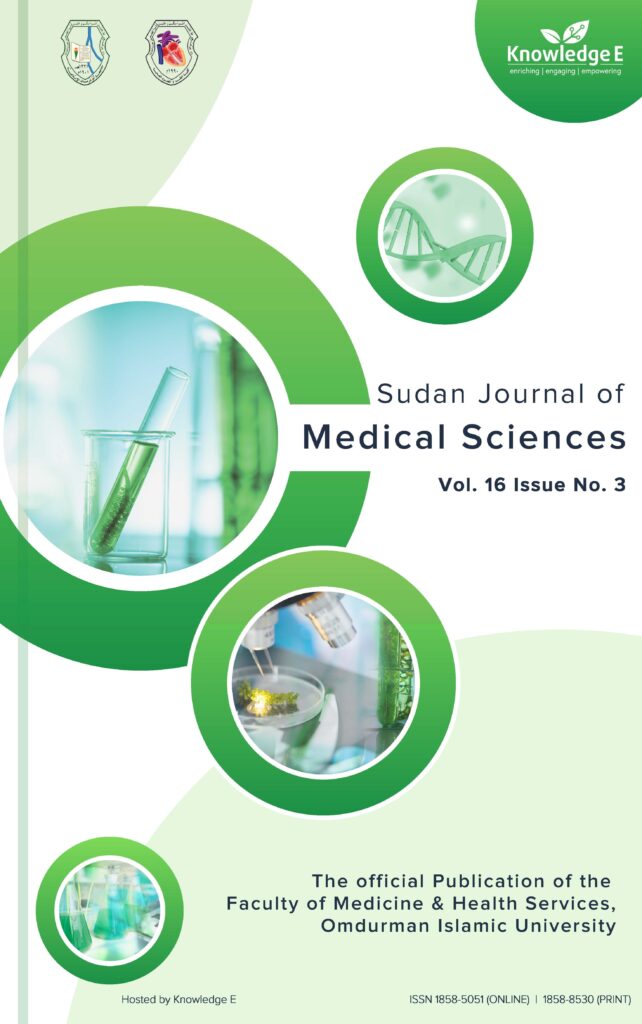
Sudan Journal of Medical Sciences
ISSN: 1858-5051
High-impact research on the latest developments in medicine and healthcare across MENA and Africa
Predictor of Spontaneous Rupture of Malarial Spleen: A Systematic Review and Meta-analysis
Published date:Mar 28 2025
Journal Title: Sudan Journal of Medical Sciences
Issue title: Sudan JMS: Volume 20 (2025), Issue No. 1
Pages:91 - 98
Authors:
Abstract:
Background: Spontaneous pathological rupture of the malarial spleen (SPRMS) is a rare but serious complication that has no known predictor in the medical literature. This study aims to report a systematic review of the search for a predictor for SPRMS and the recent changes in the management trends and outcomes of this problem.
Methods: A systematic review of 122 cases from January of 2000 through March of 2024 was conducted and linear regression was computed to search for predicting factors for SPRMS.
Results: Plasmodium vivax (P. vivax) was the most common cause of SPRMS among local citizens, while Plasmodium falciparum (P. Falciparum) was predominant among infected travelers. Fifty patients underwent splenectomy. Despite being a confounding factor in logistic regression, blood pressure could be the sole predictor of SPRMS.
Conclusion: Recent management trends have shown a tendency toward conservative treatment to preserve splenic immunological functions. To our knowledge, this is the first report on a predicting factor for SPRMS. This is important for early diagnosis and health management, as securing patient safety is a cornerstone of clinical governance in emergency settings.
Keywords: spleen, rupture, malaria
References:
[1] World Health Organization. (2017). World malaria report 2017. https://www.who.int/malaria/publications/worldmalariareport2017/ report/en/
[2] Imbert, P., Rapp, C., & Buffet, P. A. (2009). Pathological rupture of the spleen in malaria: Analysis of 55 cases (1958-2008). Travel Medicine and Infectious Disease, 7(3), 147–159. https://doi.org/10. 1016/j.tmaid.2009.01.002PMID:19411041
[3] Sarangi, J., Coleby, M., Trivella, M., & Reilly, S. (1997). Prevention of post splenectomy sepsis: A population based approach. Journal of Public Health Medicine, 19(2), 208–212. https://doi.org/10.1093/ oxfordjournals.pubmed.a024611 PMID:9243438
[4] Atkinson, E. (1874). Death from idiopathic rupture of spleen. British Medical Journal, 2(717), 403–404. https://www.jstor.org/stable/25239466 PMID:20747637
[5] Orloff, M. J., & Peskin, G. W. (1958). Spontaneous rupture of the normal spleen; a surgical enigma. International Abstracts of Surgery, 106(1), 1–11. PMID:13495867
[6] Aubrey-Bassler, F.K. & Sowers, N. (2012). 613 cases of splenic rupture without risk factors or previously diagnosed disease: A systematic review. BMC Emergency Medicine, 12, 11. https://doi.org/10.1186/ 1471-227X-12-11 PMID:22889306
[7] Ozsoy, M. F., Oncul, O., Pekkafali, Z., Pahsa, A., & Yenen, O. S. (2004). Splenic complications in malaria: Report of two cases from Turkey. Journal of Medical Microbiology, 53(12), 1255–1258. https: //doi.org/10.1099/jmm.0.05428-0 PMID:15585506
[8] Renzulli, P., Hostettler, A., Schoepfer, A. M., Gloor, B., & Candinas, D. (2009). Systematic review of atraumatic splenic rupture. British Journal of Surgery, 96(10), 1114–1121. https://doi.org/10.1002/bjs. 6737 PMID:19787754
[9] Patel, M. I. (1993). Spontaneous rupture of a malarial spleen. The Medical Journal of Australia,159(11– 12), 836–837. https://doi.org/10.5694/j.1326- 5377.1993.tb141386.x PMID:8264491
[10] Hwang J. & Lee C. Malaria-induced splenic infarction. (2014). The American Society of Tropical Medicine and Hygiene, 91(6), 1094–1100. https://doi.org/10.4269/ajtmh.14-0190.
[11] Elagali, A., Ahmed, A., Makki, N., Ismail, H., Ajak, M., Alene, K. A., Weiss, D. J., Mohammed, A. A., Abubakr, M., Cameron, E., Gething, P., & Elagali, A. (2022). Spatiotemporal mapping of malaria incidence in Sudan using routine surveillance data. Scientific Reports, 12(1), 14114. https://doi.org/10.1038/s41598- 022-16706-1 PMID:35982088
[12] Urban, B. C., Hien, T. T., Day, N. P., Phu, N. H., Roberts, R., Pongponratn, E., Jones, M., Mai, N. T., Bethell, D., Turner, G. D., Ferguson, D., White, N. J., & Roberts, D. J. (2005). Fatal Plasmodium falciparum malaria causes specific patterns of splenic architectural disorganization. Infection and Immunity, 73(4), 1986–1994. https://doi.org/10.1128/IAI.73.4.1986- 1994.2005PMID:15784539
[13] Norman, F. F., Rojas-Marcos, J., Hermida-Donate, J. M., Monge-Maillo, B., Perez-Molina, J. A., & López- Vélez, R. (2014). Splenic infarction and malaria. Transactions of the Royal Society of Tropical Medicine and Hygiene, 108, 455–460. https://doi. org/10.1093/trstmh/tru095
[14] Davidson, R. N., & Wall, R. A. (2001). Prevention and management of infections in patients without a spleen. Clinical Microbiology and Infection, 7(12), 657–660. https://doi.org/10.1046/j.1198-743x.2001. 00355.x PMID:11843905
[15] Yagmur, Y., Kara, I. H., Aldemir, M., Büyükbayram, H., Tacyildiz, I. H., & Keles, C. (2000). Spontaneous rupture of malarial spleen: Two case reports and review of literature. Critical Care, 4(5), 309–313. https://doi.org/10.1186/cc713 PMID:11056757
[16] Jacobs, F. M., Prat, D., Petit, F., Smadja, C., & Brivet, F. G. (2005). Spontaneous rupture of the spleen during malaria: A conservative treatment approach may be appropriate. Clinical Infectious Diseases, 40(12), 1858–1859. https://doi.org/10.1086/430446 PMID:15909278
[17] Bonnard, P., Guiard-Schmid, J. B., Develoux, M., Rozenbaum, W., & Pialoux, G. (2005). Splenic infarction during acute malaria. Transactions of the Royal Society of Tropical Medicine and Hygiene, 99(1), 82–86. https://doi.org/10.1016/j.trstmh.2004.06.005 PMID:15550267
[18] Raikhlin, A., & Baerlocher, M. O., Murray, R. A., & Myers, A. (2008). Imaging and transcatheter arterial embolisation for traumatic splenic injuries: A review of the literature. Canadian Journal of Surgery, 51(6), 464–472. PMID:19057735
[19] Tauro, L. F., Maroli, R., D’Souza, C. R., Hegde, B. R., Shetty, S. R., & Shenoy, D. (2007). Spontaneous rupture of the malarial spleen. Saudi Journal of Gastroenterology, 13(4), 163–167. https://doi.org/10.4103/1319- 3767.36745 PMID:19858639